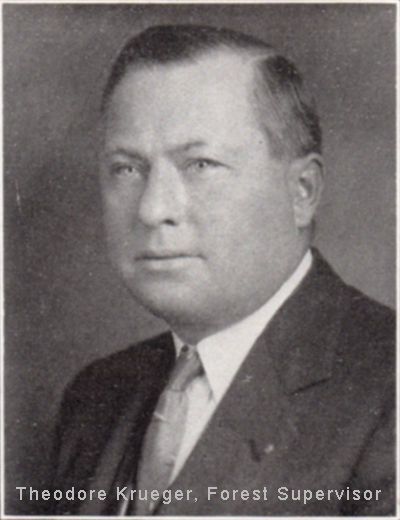Category: History Date: 2020-10-19
CCC in Black Hills National Forests
By Theodore Krueger, Supervisor Black Hills National Forest
From a 1933 CCC annual

The President's emergency conservation work as carried out by the Civilian Conservation Corps in the Black Hills means the accomplishment of needed useful work on federal lands.
Between May 14 and June 20, 1933, six national forest camps were established in the Black Hills national forest and five camps on the Harney national forest in western South Dakota. The number of men engaged in effective field work during the first six months enrollment period varied from month to month, but for September 1933, the number was 1867, which may be taken as a fair average. The responsibility for operating the camps is divided between the U. S. Army and the U. S. Forest Service of the Department of Agriculture. The Army is responsible for the organization and maintenance of the camps, and the Forest Service for the work done in the woods.
Because of favorable conditions of growth in this region, young trees grow in such numbers that stagnation in the stand takes place, and satisfactory growth is impossible. Stands of young trees numbering from two thousand to three thousand and more an acre is not uncommon. In such numbers the trees cannot get enough moisture and nutriment from the soil. There were 12,000 acres of such stands thinned by the CCC in the Black Hills during 1933. Five hundred to twelve hundred trees to the acre are left, depending on the height of the trees. All the damaged and suppressed trees are removed, so that the remainder, with plenty of room, should grow into splendid forests.
Many hundreds of acres of excellent range have been made usable by the development of reservoirs and springs, the construction of livestock driveways, etc. Cattle and sheep cannot use range if they must travel too far to water. Other portions of range have been, made usable by drift fences which keep the cattle from drifting to more desirable range and leaving the poorer portions unutilized.
A total of 35 miles of truck trails and other trails were constructed, and 168 miles of existing roads were improved and maintained. These roads and trails are for use, not only by forest officers in administration and protection of the forests, but by tourists, settlers, and the public generally.
Many campgrounds have been improved by clearing and the installation of sanitary and other facilities to enable the traveling public to enjoy the recreational resources of the forests more fully.
Twenty-eight thousand acres of forest land have been treated to kill porcupines and other rodents. These animals live largely by eating the bark of pines, thereby killing the tree. The poisoning of these pests will protect the trees. Other rodents consume range plants.
Ten thousand cords of firewood taken from improvement thinnings were cut, hauled to the railroad and loaded on cars for shipment to the drought-stricken areas of South Dakota to help relieve the distress in that region. This wood was distributed through the South Dakota State Relief Committee. In addition, hundreds of loads of firewood are hauled out by people in surrounding country, some coming over one hundred miles to truck out firewood which is given free to needy people.
Almost three thousand man-days fighting forest fires were spent by the CCC boys; most of this was on the Clinton fire north of Deerfield. Largely through the prompt and energetic action of enrollees, this fire, which occurred in the midst of a dense tangle of blow-down material, resulting from a cyclone in May 1933, was held to 207 acres.
Control of incipient erosion was affected on 3000 acres.
In addition to the major projects of work mentioned, many other smaller ones, too numerous to mention, of both construction and maintenance, were accomplished. All of these jobs are worthwhile and will be very beneficial to the users of the national forests in years to come.
From the human element standpoint, there has been a marked change in the boys themselves. All have gained weight and are in much better condition physically than when enrolled. For many it was their first job, and they have learned to handle. many kinds of tools and to do useful work. The morale of all is excellent.
For the winter period, which started November 1, 1933, there are fifteen camps in operation in the two Black Hills National Forests, and in addition two state camps in the Custer State Park.
My observation of the CCC work in the Black Hills National Forest has been that the enrollees appreciate the opportunity given them to earn their wages through useful work that will be of benefit not only for the present, but also in the future.
Useful work that will be of benefit not only for the present, but also in the future.






